Anker Prime TB5 14-in-1 Docking Station: 30-second review
The Anker Prime Docking Station is a powerful unit with plenty of ports that employ the latest standards, serving the needs of creatives and other power users.
It’s rather elegant for a docking station, thanks to the premium grey metallic finish and vibrant blue light ring, which is bright enough to notice without causing distraction.
Build quality is also impressive, rivalling the best laptop docking station constructions. Every panel is solid, and the rubber feet are robust and provide plenty of dampening and protection.
However, its tall, square form could be inconducive to certain setups, since it might not fit under monitor stands and shelves. This is less of a problem for typical docking stations with their thin, rectangular shapes.
My other gripe with the Prime Docking Station concerns its power button, which isn’t very tactile and can be awkward to use. My presses would sometimes fail to register, and I wish the hold time was shorter when powering it down.
There are plenty of ports on the Prime Docking Station (14 in total), including upstreaming and downstreaming USB-C ports at the back. Both of these employ the Thunderbolt 5 standard and can also provide charge: the former at 140W and the latter 15W.
What’s more, the two downstreaming ports can support dual 8K monitors (6K when connected to macOS devices), and either can be used in conjunction with the HDMI port or the DisplayPort. Only two external monitors can be used at the same time, though, and the HDMI and DisplayPort can’t be used simultaneously, either.
The front two USB-C ports provide a combined output of 45W, which is sufficient for fast charging numerous devices. Other ports include three USB-A ports, readers for SD and TF cards, and a 3.5mm audio jack.
All of these ports function well, providing fast and stable data transmission and multi-device charging. However, there were a few occasions where my external displays lost signal for a second or so, or failed to display altogether, usually when booting up my laptop for the first time of the day.
This required a simple re-plug of the upstreaming cable to remedy, and these occurrences weren’t frequent enough to disrupt the overall experience. What’s more, I believe at least part of the blame lies with the poor multi-display optimization of Windows 11, rather than with the dock itself.
The audio jack, on the other hand, is somewhat of a let down, failing to deliver as much bass and fidelity as when connecting my headphones directly to my laptop.
The main drawback of the Prime Docking Station, though, is the price. At $400 / £400, it’s seriously expensive, and only worth the outlay if you’ll actually be using two 8K or 6K monitors, and have multiple devices to charge and peripherals to connect at once.
Anker Prime TB5 14-in-1 Docking Station: Price & availability
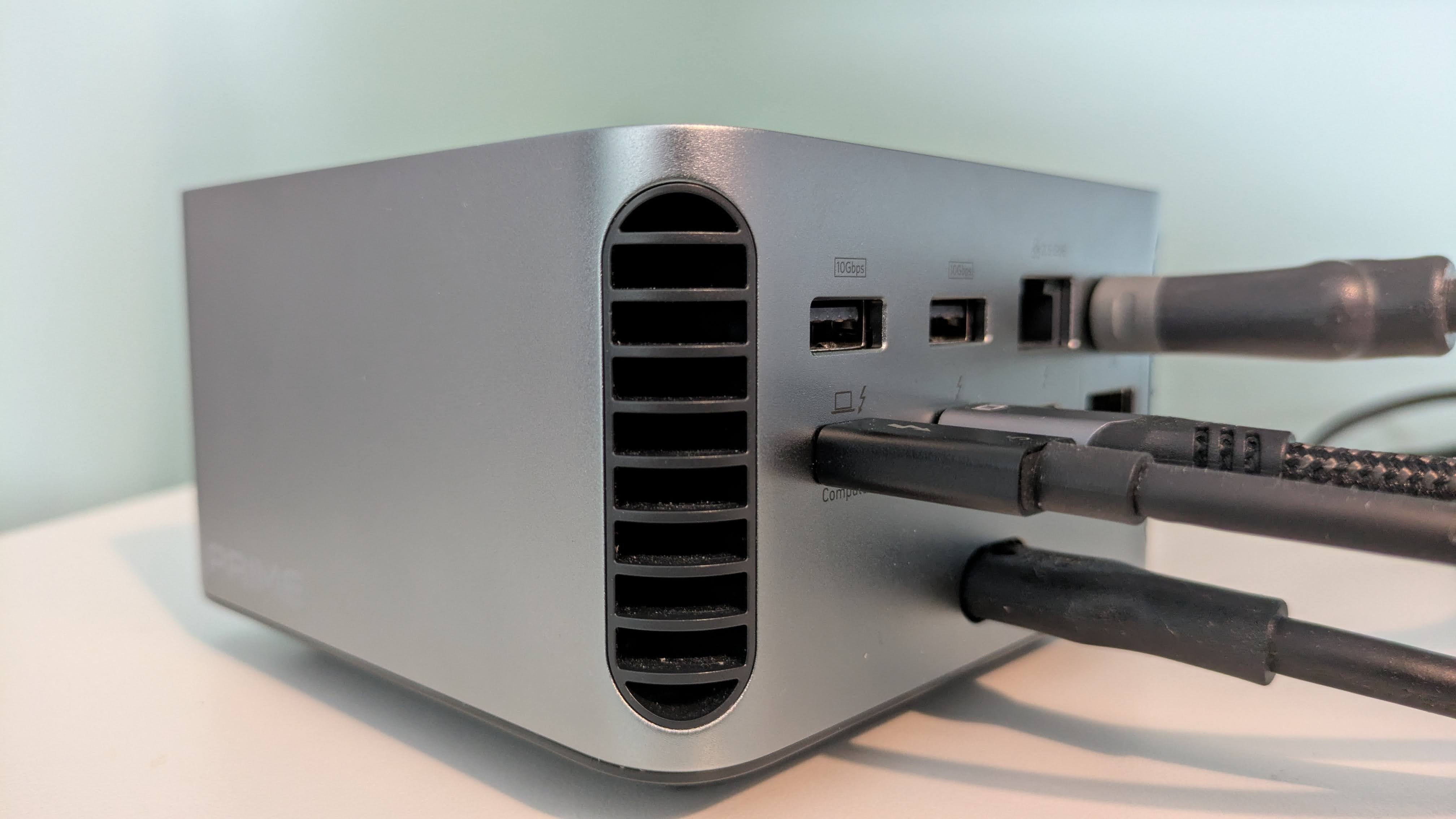
- $399.99 / £399.99 (about AU$610)
- Available now in the US and the UK
- High-end of the market
The Anker Prime Docking Station costs $399.99 / £399.99 (about AU$610) and is available via Anker's website here, as well as online retailers including Amazon.com and Amazon.co.uk.
While there are many docking stations in the same ballpark, there are also plenty of cheaper alternatives. This includes the Kensington SD5000T5 EQ, which costs considerably less despite having a comparable spec. It also has a slimmer design to boot – no wonder we think it’s one of the best Thunderbolt 5 laptop docks around.
- Value: 3 / 5
Anker Prime TB5 14-in-1 Docking Station: Specs
Swipe to scroll horizontally
Compatibility: | USB-C |
Number of Ports: | 14 |
Ports front: | 2x USB-C, 1x USB-A, 1x audio jack, 1x SD card reader (left side), 1x TF card reader (left side) |
Ports back: | AC power input, 1x USB 3.2 Gen 2 Type-A, 1x USB 2.0, 1x HDMI 2.1, 1x DisplayPort 2.1, 1x 2.5GbE Ethernet |
Downstream power: | 2x 15W USB-C (Thunderbolt 5) |
Upstream power: | 140W USB-C (Thunderbolt 5) |
Size: | 4.6 x 4.6 x 3.0in / 116 x 116 x 75mm |
Weight: | 38oz / 1,086g |
Accessories: | USB-C cable (Thunderbolt 5) |
Anker Prime TB5 14-in-1 Docking Station: Design
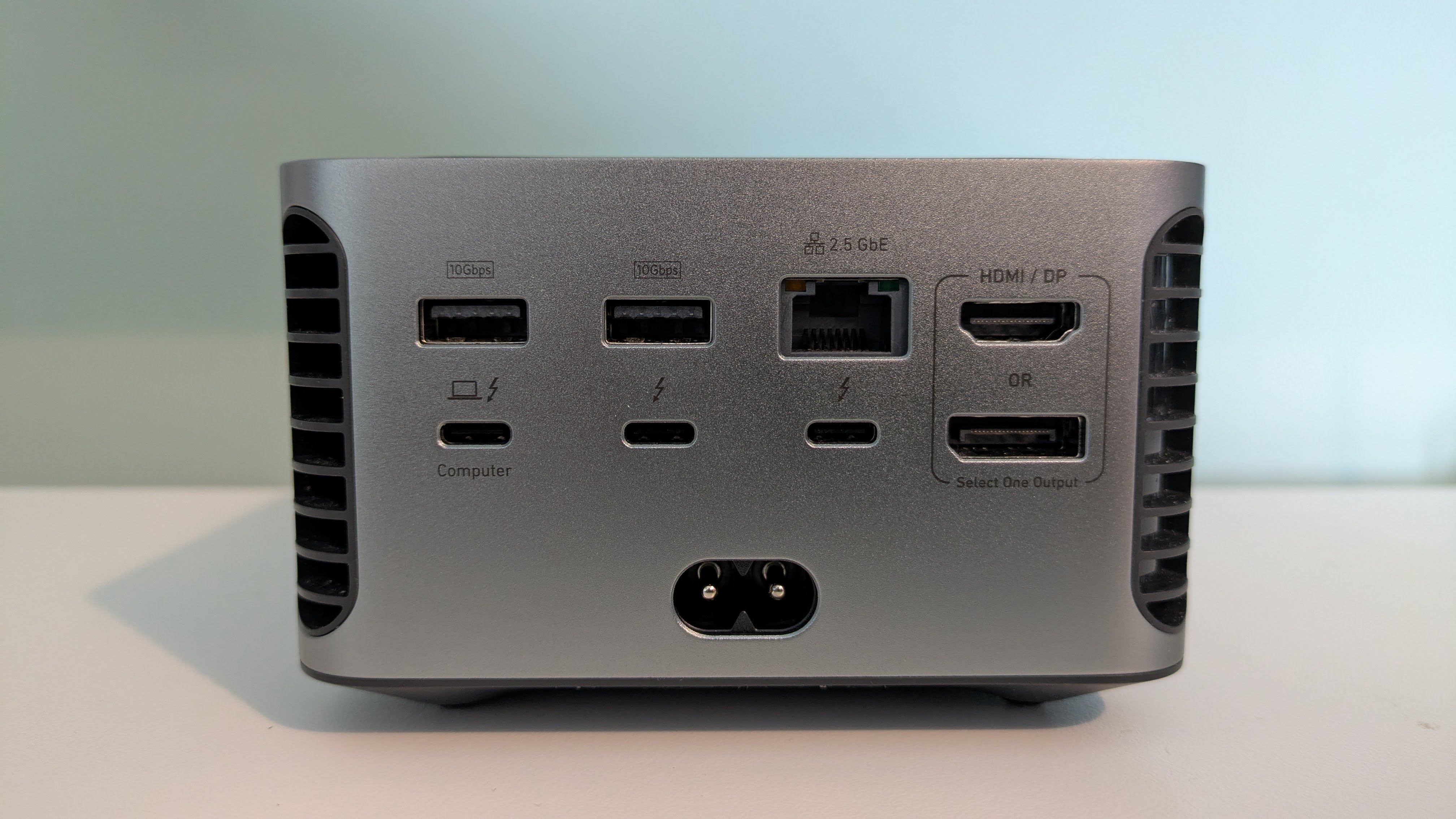
- Solid build quality
- Premium looks
- Divisive boxy shape
The Prime Docking Station certainly looks sleek, with its dark grey metallic body, which is nicely complemented by the blue light ring around the top edge. This is bright enough to add interest, but dim enough to avoid being a distraction. Even the rear vents are stylishly designed, and help to make it fit for any professional environment.
While it’s pleasingly thin across its width, the Prime Docking Station is quite tall and thick across its depth. This might prove to be an issue for those looking to slot it underneath their monitor stand or similar, as I doubt it’ll fit comfortably under all of them.
There’s no denying the premium construction of the Prime Docking Station, though. It’s extremely solid and sturdy, and the four rubber feet are certainly thick enough to dampen any operating vibrations and protect your desktop surface.
The power button, however, is a slight misstep. It doesn’t feel very tactile, and it can be hard to tell when you’ve actually pressed it properly. There were numerous occasions when I thought I’d pressed it, but it failed to actuate.
- Design: 3.5 / 5
Anker Prime TB5 14-in-1 Docking Station: Features
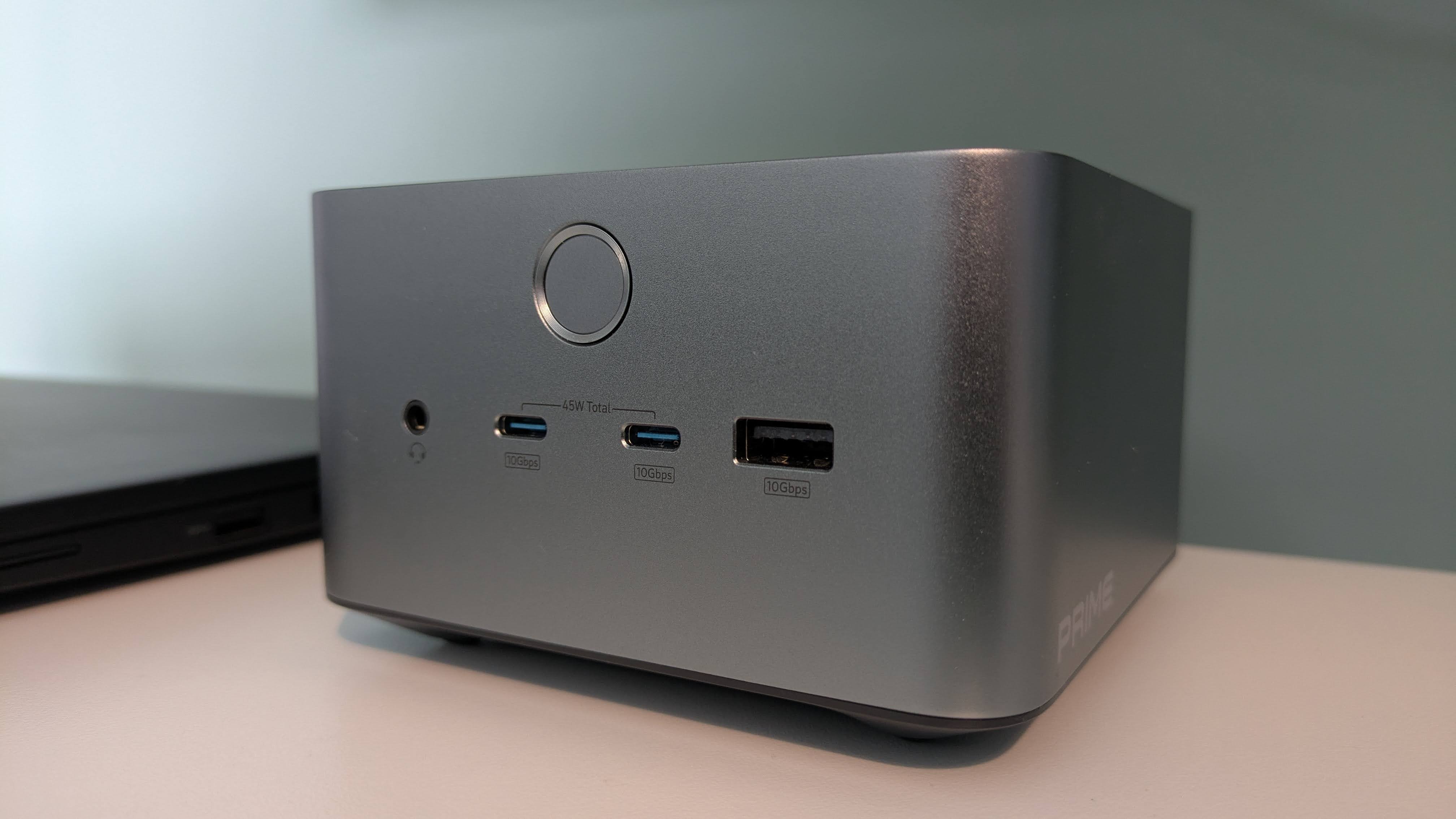
- 14 ports
- Thunderbolt 5 support
- Blue light indicator
The Prime Docking Station has three Thunderbolt 5 ports, all located on the back. One is for upstreaming and also provides 140W of PD charging. The other two are for downstreaming and each supports 8K monitors (or 6K if used with a macOS device). They’re also capable of transferring data at 120Gbps and charging at 15W.
Also on the back is an HDMI port and a DisplayPort, although both can’t be used at the same time. If two connections are present, the latter will take precedent. Thankfully, either of these ports can be used in conjunction with one of the Thunderbolt 5 ports for dual-display setups. Unfortunately, though, the Prime Docking Station can’t support three external monitors.
Rounding out the rear interfaces are two USB-A ports, each of which is capable of data transfer speeds of up to 10Gbps. On the left side you’ll find TF and SD card readers, the latter of which accepts most form factors.
The front of the Prime Docking Station features two more USB-C ports – each with a data transfer speed of up to 10Gbps and a combined 45W output – and one more USB-A port, again capable of transferring data at 10Gbps. A 3.5mm Aux jack is also present for connecting headphones and other output devices.
The aforementioned blue light ring isn’t just for show: it also acts as a status indicator. It remains solid when the Prime Docking Station is powered on, and flashes twice when the upstream port is connected and in Thunderbolt 5 or 4 mode.
When the Prime Docking Station is running intense workloads involving high data transmission speeds, such as when gaming with high resolution monitors, a moving pattern is displayed. The light can be turned off altogether by pressing the power button once, while holding it for five seconds turns the entire unit off, which is slightly too long to be convenient in my view.
Accompanying software is available for the Prime Docking Station, but it’s very basic, used merely to download firmware updates and view the manual, which can also be downloaded as a PDF.
- Features: 4.5 / 5
Anker Prime TB5 14-in-1 Docking Station: Performance
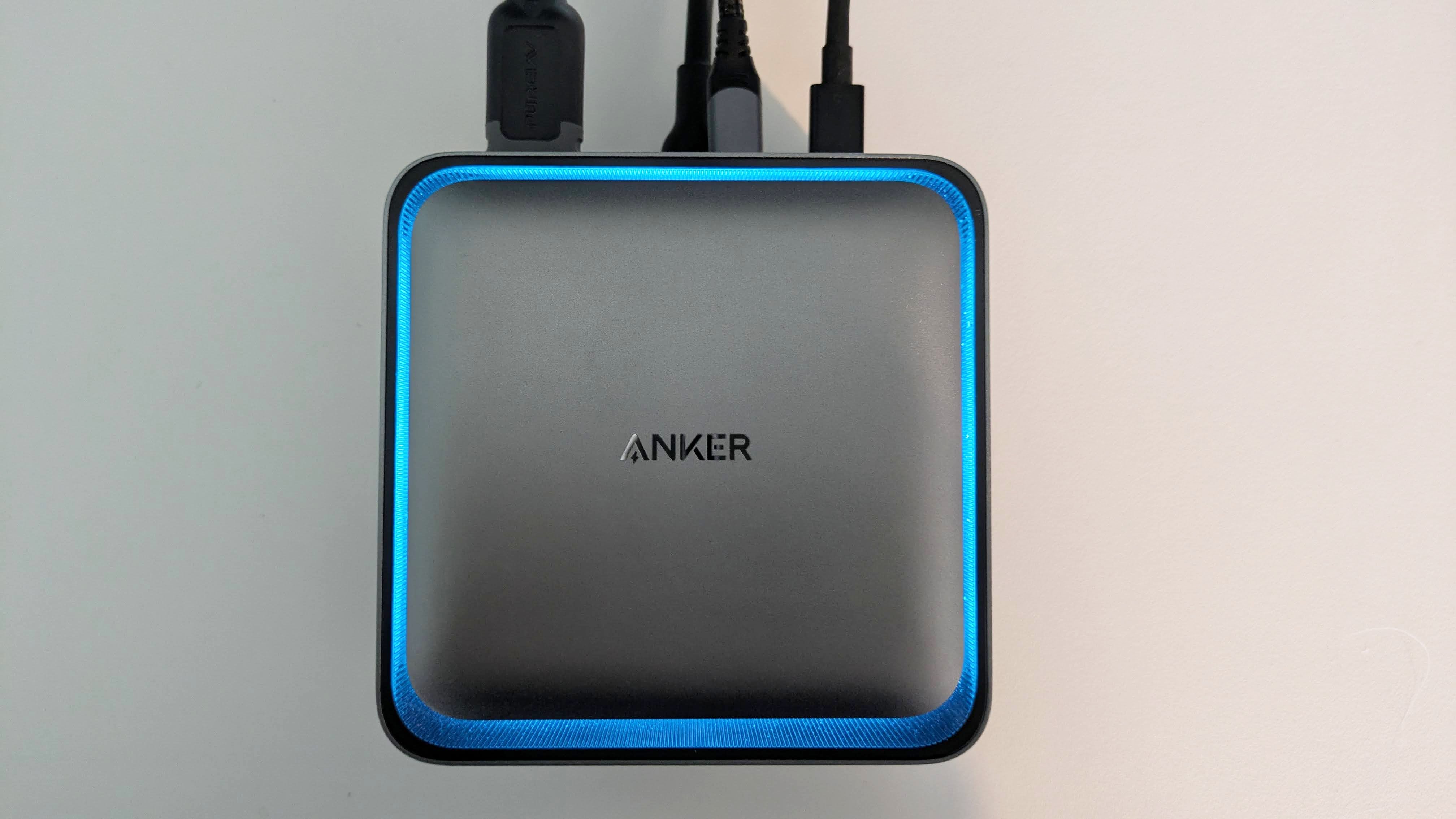
- Seamless connectivity and charging
- Minor external monitor issues
- Awkward power button
Given the spec of the Prime Docking Station, it’s no surprise overall performance is fast and seamless. One of the immediate drawbacks of this power, though, is the fact that AC power is required at all times, so you’ll need a spare outlet nearby.
The Thunderbolt 5, HDMI and Displayport interfaces all provide stable connections to external monitors, although there were a few occasions where one of my connected displays would go black for a couple of seconds before coming back. There were also times when neither one of them was recognized, requiring me to reconnect the upstreaming cable to my laptop.
However, this could be a fault of my laptop rather than with the dock, as Windows 11 devices are known to be somewhat unreliable when handling multiple displays.
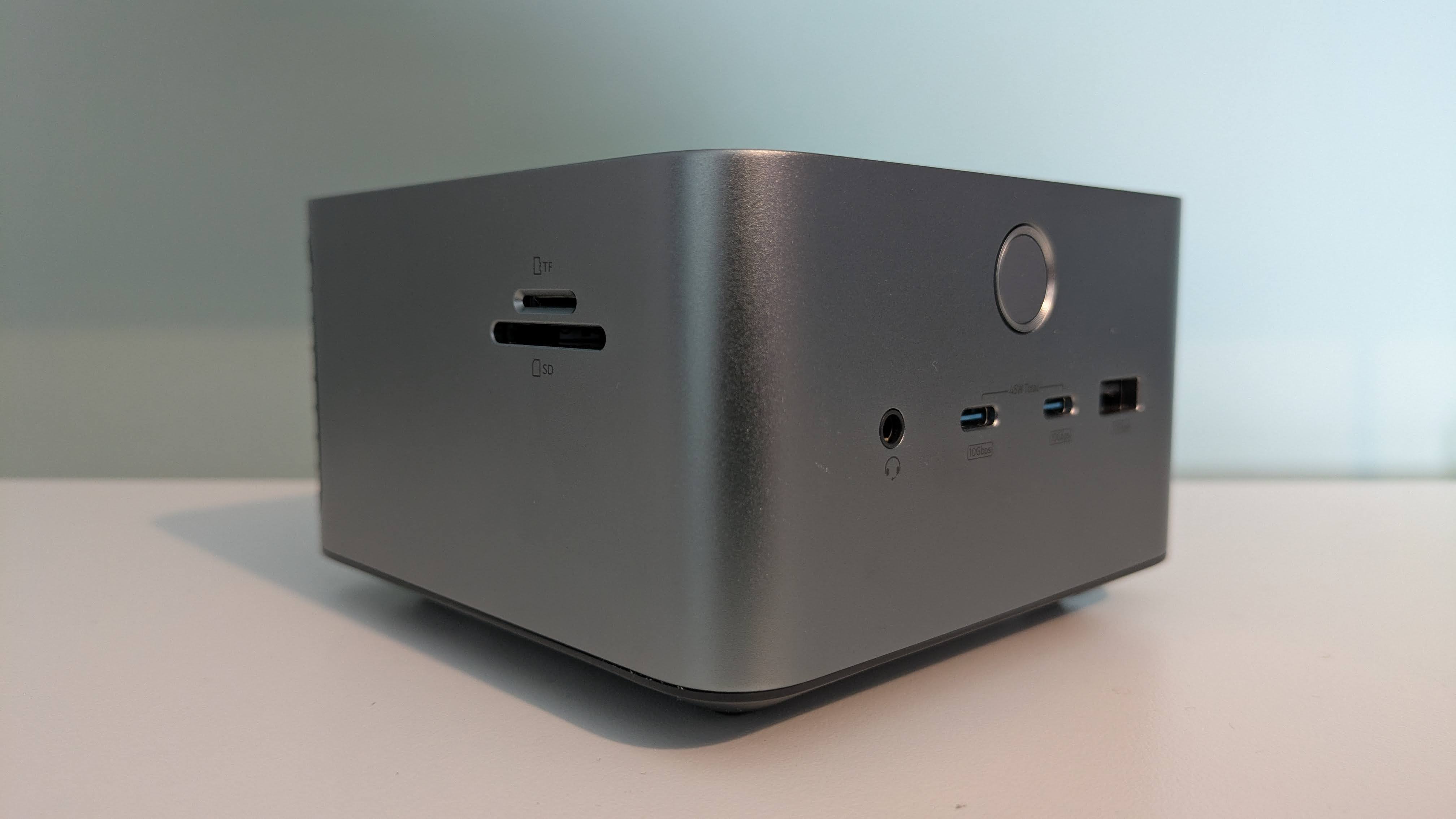
Connected peripherals, on the other hand, worked flawlessly in my experience. Mice and keyboards worked and charged just as well as if they were connected directly, and the same can be said of the read and write speeds of the SD card I inserted into the reader.
The audio jack, however, proved somewhat of a disappointment. Low end frequencies were noticeably weaker through my headphones, and overall fidelity seemed slightly compromised, too.
When dealing with high workloads, such as … multiple USB ports simultaneously, the Prime Docking Station does produce some fan noise. Mercifully, though, this isn’t loud enough to disturb, and neither is the small amount of heat that’s generated.
- Performance: 4 / 5
Anker Prime TB5 14-in-1 Docking Station: Report card
Swipe to scroll horizontally
Value | This is one expensive docking station, and only worth it for those who’ll make the most of what it has to offer. | 3 / 5 |
Design | It’s very well engineered, but that cube shape might prove incongruous for certain setups. | 3.5 / 5 |
Features | With plenty of ports employing the latest standards, power users should be pleased. | 4.5 / 5 |
Performance | Peripheral connections and multi-device charging are taken in its stride, and there are only a few minor hiccups when using multiple displays. | 4 / 5 |
Overall | The Prime Docking Station is a powerful unit, but one with a somewhat cumbersome design and a price tag that only makes sense if you plan on using it to its fullest potential. | 3.5 / 5 |
Should I buy the Anker Prime TB5 14-in-1 Docking Station?
Buy it if...
You want good looks and build quality
It’s certainly smart and sophisticated, and feels as premium as it should do at this price.
You want powerful interfaces
The multiple Thunderbolt 5 ports will please power hungry and 6/8K dual-monitor users.
Don't buy it if...
You want something thin
It may be compact in terms of length, but it’s quite tall and thick, which might not fit so well with certain setups.
You want to save money
The Prime Docking Station is far from cheap, and unless you really need all of its power and capabilities, there are better value alternatives.
Also consider
Kensington SD5000T5 EQ
If you need Thunderbolt 5 ports but are on a tighter budget, the SD5000T5 EQ is a sound choice. This is a fast and well-made unit, as well as being versatile thanks to its 11 ports. Like the Prime Docking Station, the SD5000T5 EQ also requires power from an outlet.
Read our full Kensington SD5000T5 EQ review.
IOGear Dock Pro
Our pick as the best docking station overall, the IOGear Dock Pro is a great all-rounder. There are no less than four HDMI/DisplayPort interfaces, and it can be powered with a PSU or via a USB-C cable. We did find it can get quite hot after a while, and there’s only one USB-C port on the entire unit, but these are about the only drawbacks.
Read our full IOGear Dock Pro review.









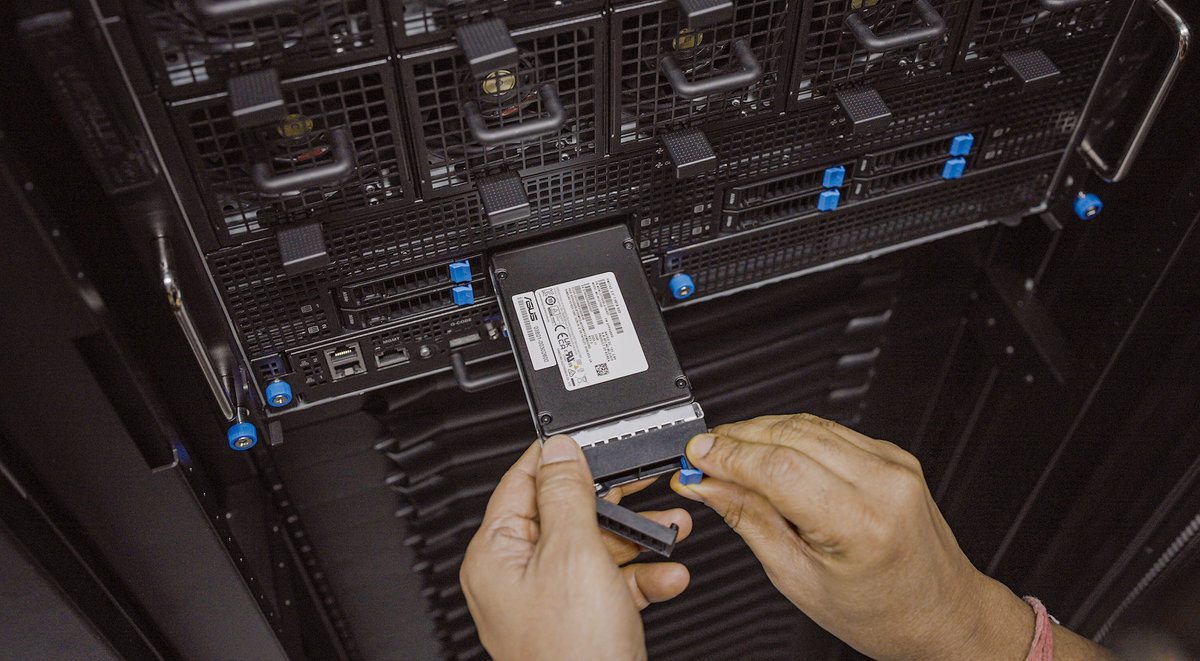
 English (US) ·
English (US) ·